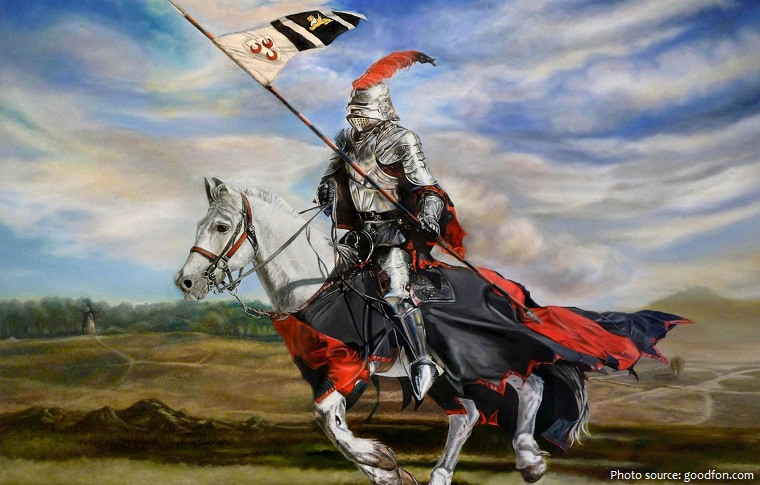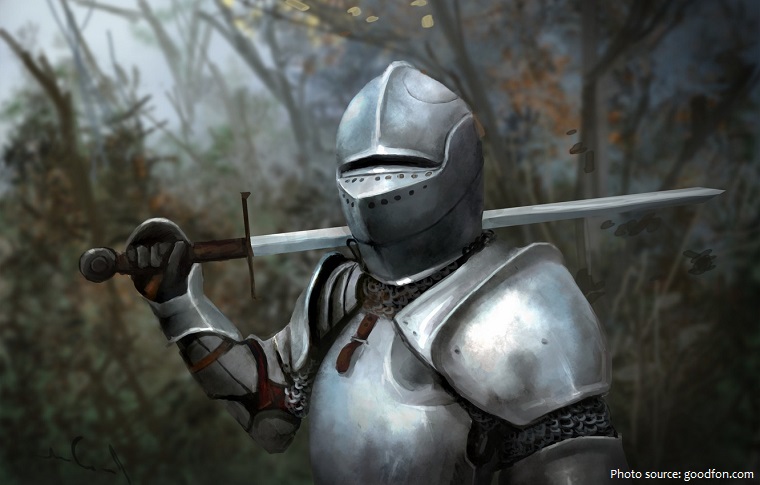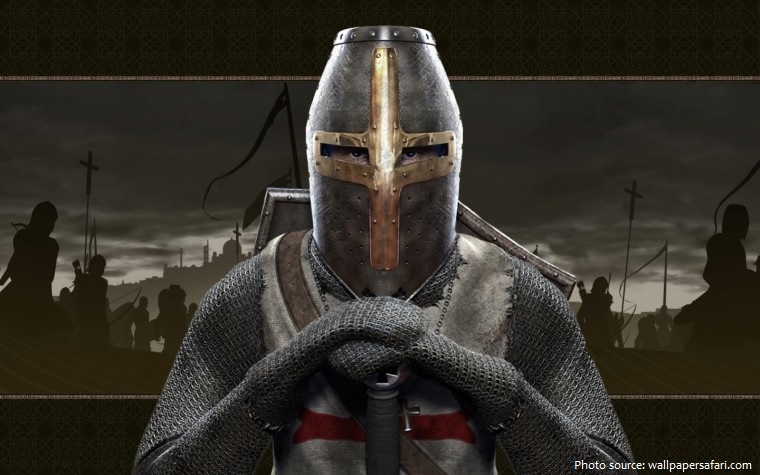
In the Middle Ages knight was a man who served his sovereign or lord as a mounted soldier in armour. Today, it is a title of honour bestowed for a variety of services.
The word “knight”, from Old English cniht (“boy” or “servant”), is a cognate of the German word Knecht (“servant, bondsman, vassal”).
In the Early Middle Ages medieval knights were professional cavalry warriors, some of whom were vassals holding lands as fiefs from the lords in whose armies they served, while others were not enfeoffed with land.
During the High Middle Ages, knighthood was considered a class of lower nobility.

By the Late Middle Ages, the rank had become associated with the ideals of chivalry, a code of conduct for the perfect courtly Christian warrior.
Knights in armour figured in English history for around 450 years, but what they wore and how they fought changed a lot over this time. First appearing at the Battle of Hastings in 1066, Norman knights like the one illustrated here, wore long chain-mail shirts (‘hauberks’) and pointed, open-faced helmets. They carried long kite-shaped shields, and fought with swords and long spears, used over-arm or thrown like javelins. You can visit the place where Norman knights triumphed at the 1066 Battle of Hastings Abbey and Battlefield.
During the Barons’ Wars and the Welsh and Scottish wars of the 1200s, closed ‘great helms’ covered the knight’s face, and they couldn’t be recognised – so they painted combinations of colours, shapes and animals on their shields, banners and surcoats. This ‘heraldry’ showed people who a knight was. Firmly seated on their horses on built-up saddles, they used their lances underarm to deliver unstoppable cavalry charges in battle or tournament.

Naturally, as leaders of armies, knights were responsible for winning and losing — some of the most important battles of the Middle Ages. But they also made history in other ways. Many held important religious positions as well as military ones. Some were writers of history and poetry, helping to craft the image of the knight that we still know today.
The process of becoming a knight started from early childhood. The typical starting point for a young lad of 7 to 10 years old was to become a page when he learned to handle horses, hunt, and use mock weapons while serving a knight proper. From age 14, the next step was to become a squire (or esquire), who had more responsibility than a page, learned to use real weapons, and started an education, especially the study of chivalry. Squires assisted knights in peace and war, holding their extra lances or shield, cleaning their armour, and looking after the several horses each knight owned. If all went well, the youth, by then around 18 years old, was made a knight in a ceremony known as a dubbing.

For a dubbing, a soon-to-be knight had a good bath and kept a church vigil overnight. On the day of the ceremony the squire was dressed by two knights with a white tunic and white belt to symbolise purity, black or brown stockings to represent the earth to which he will one day return, and a scarlet cloak for the blood he is now ready to spill for his baron, sovereign, and church. He was given his sword back, now blessed by a priest with the proviso he always protect the poor and weak. The blade had two cutting edges – one to represent justice, the other loyalty and chivalry.
Knights were expected, above all, to fight bravely and to display military professionalism and courtesy. When knights were taken as prisoners of war, they were customarily held for ransom in somewhat comfortable surroundings. This same standard of conduct did not apply to non-knights (archers, peasants, foot-soldiers, etc.) who were often slaughtered after capture, and who were viewed during battle as mere impediments to knights’ getting to other knights to fight them.

In peacetime, knights often demonstrated their martial skills in tournaments, which usually took place on the grounds of a castle. Knights can parade their armour and banner to the whole court as the tournament
commenced. Medieval tournaments were made up of martial sports called hastiludes, and were not only a major spectator sport but also played as a real combat simulation. It usually ended with many knights either injured or even killed. Tournaments were held often because of coronations, the marriage of kings, births, baptisms, weddings of princesses, conquests, peace, alliances, welcoming ambassadors or people of great worth, and even other minor events, experienced by the nobility.
One of the greatest distinguishing marks of the knightly class was the flying of coloured banners, to display power and to distinguish knights in battle and in tournaments. Knights are generally armigerous (bearing a coat of arms), and indeed they played an essential role in the development of heraldry. As heavier armour, including enlarged shields and enclosed helmets, developed in the Middle Ages, the need for marks of identification arose, and with coloured shields and surcoats, coat armoury was born. Armorial rolls were created to record the knights of various regions or those who participated in various tournaments.

Knights were amongst the most dedicated of all medieval fashion followers, indeed, other professions such as the clergy were often rebuked for trying to make themselves look as flashy as the knights did. Although clothes were not too dissimilar between the classes, those who could afford it tended to wear better quality materials with a much better fit. Tunics (long, short, padded, sleeveless or long-sleeved), stockings, cloaks, gloves, and hats of all shapes and sizes were all worn.
The most common material was wool, but silk, brocade, camel hair, and furs allowed a knight to make a fashion statement. Bright colours were favoured such as crimson, blue, yellow, green, and purple.